Key takeaways:
- Documentary filmmaking emphasizes authenticity and the emotional connection of real stories, allowing audiences to empathize and reflect.
- Flexibility and adaptability are essential during production, as unexpected events can significantly alter the direction of a documentary.
- Developing a compelling concept starts with curiosity and immersion in the subject matter to refine the focus and create relatable narratives.
- Collaboration, active listening, and embracing imperfection can enhance storytelling, allowing for deeper insights and authenticity in the final product.
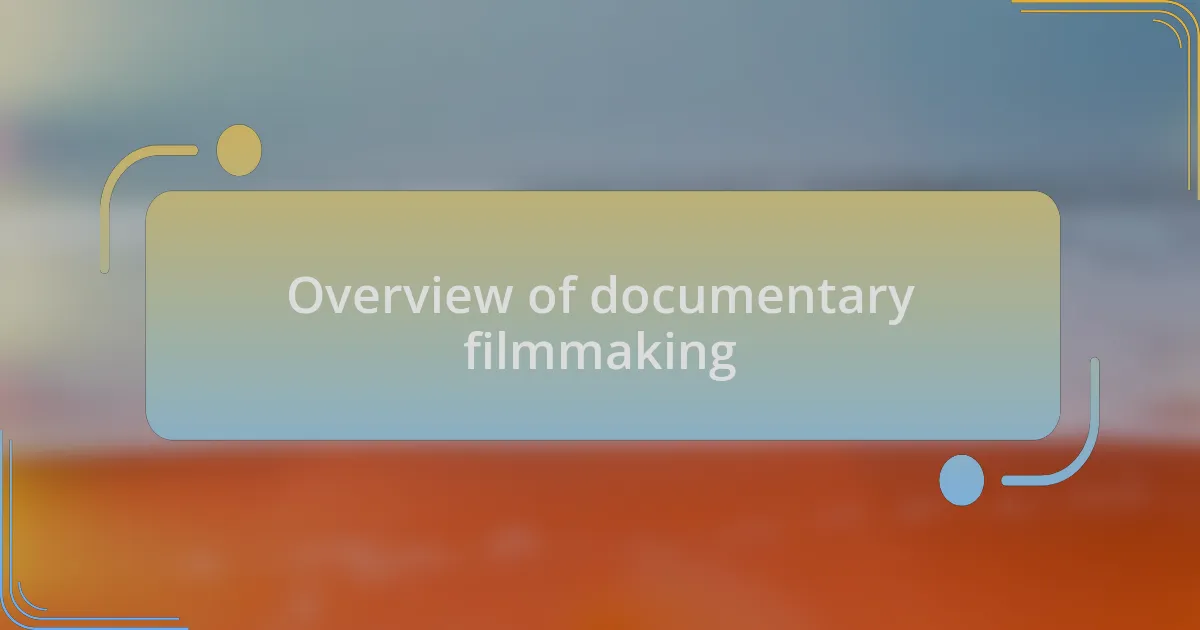
Overview of documentary filmmaking
Documentary filmmaking is a unique art form that seeks to tell true stories, often shedding light on issues that are overlooked or misunderstood. I remember working on a documentary about climate change, and the challenge was not just capturing stunning visuals but also conveying the urgency and emotion behind the statistics. When I think about it, how can we truly grasp the weight of these pressing issues without the heart of a story anchoring our understanding?
What sets documentaries apart is their commitment to authenticity. Each film strives to represent real life and real events, and I’ve found that this sincerity resonates deeply with audiences. There’s something profoundly moving about watching someone’s journey unfold on screen, isn’t there? It connects us in ways that fiction sometimes cannot, inviting us to empathize and reflect on our own lives.
In my experience, the process of documentary filmmaking can be as unpredictable as the stories themselves. For instance, while shooting an interview, unexpected emotions surfaced, transforming the direction of our film. It made me realize how important it is to be open and adaptable when telling someone else’s story. After all, isn’t it often the unexpected moments that leave the most lasting impression on both filmmakers and viewers?
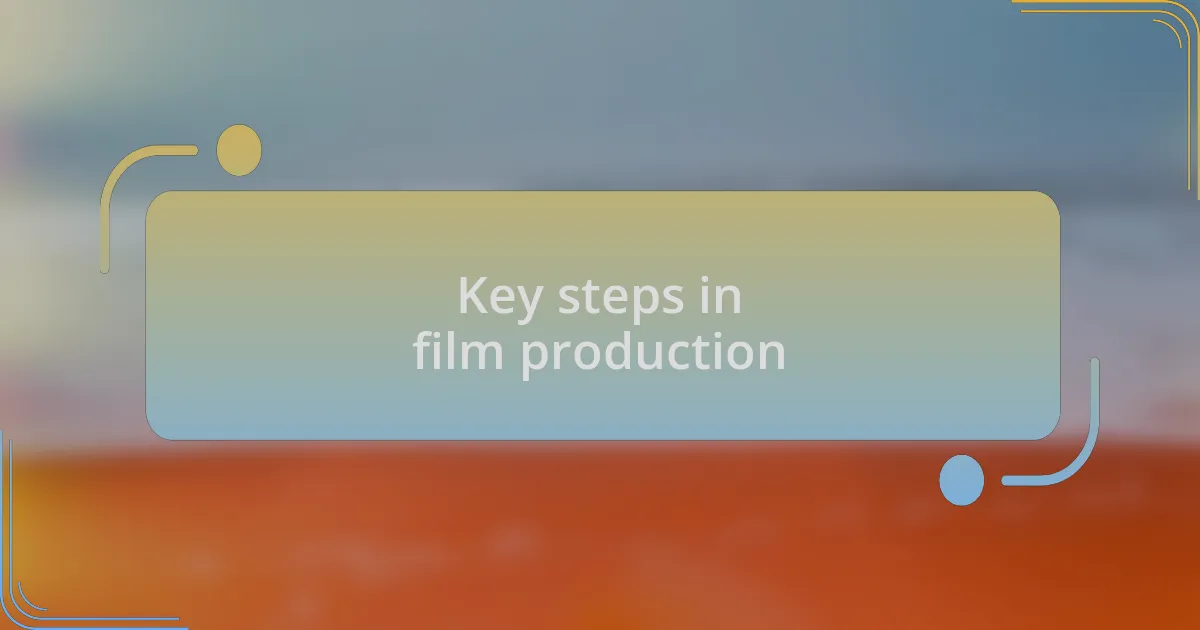
Key steps in film production
When it comes to film production, pre-production is undeniably a crucial phase. Gathering the right team, scouting locations, and planning interviews sets the foundation for everything that follows. I vividly recall the time I spent weeks orchestrating logistics for a documentary on community gardens. Every detail mattered, from securing permissions to scheduling interviews with passionate gardeners, all of which ultimately made the final product more authentic and complete.
Once filming begins, the importance of adaptability becomes starkly evident. I remember battling unexpected weather conditions during an outdoor shoot, which forced us to pivot and find creative shooting angles. That experience taught me that flexibility is not just nice to have; it’s essential. Planning and execution are vital, but so is the ability to embrace spontaneity when the story takes an unexpected turn.
Finally, post-production is where all the pieces come together. This stage can feel overwhelming, but it offers a unique opportunity to refine the narrative. I once spent countless hours in the editing suite, staring at footage that didn’t initially connect, only to eventually discover a thread that wove everything together beautifully. It’s in these moments of introspection that we really grasp how editing can mold our film’s voice, isn’t it? Each cut and transition serves to tell a story that resonates, allowing us to impact our audience powerfully.

Essential equipment for filmmakers
When diving into documentary filmmaking, the right equipment is essential to capture compelling stories. I will never forget the first time I invested in a quality camera rig. It wasn’t just about the brand; it was the ability to shoot in low light that transformed my nighttime interviews. I remember feeling like a kid in a candy store as I watched the footage come to life, something I could never achieve with my old gear. Isn’t it amazing how the right tool can unlock your creative potential?
Alongside cameras, sound equipment should never be an afterthought. During my initial projects, I relied on the built-in mics, which resulted in more than a few cringe-worthy audio errors. After learning this the hard way, I made it a priority to use external microphones, and the improvement was staggering. Have you ever listened to a beautifully crafted story only to be distracted by poor sound? I realized then that clear audio is just as vital as stunning visuals for immersing the audience in the narrative.
Finally, sturdy lighting kits can transform a scene. I distinctly remember one shoot where natural light just wasn’t cooperating. With overcast skies threatening my vision, I quickly set up portable lights, and wow, what a difference! Lighting can change the mood and tone of your film dramatically. Isn’t it fulfilling to know that mastering these elements can elevate your storytelling? Investing in the right equipment is more than just a technical choice; it’s a commitment to delivering the best experience for your audience.
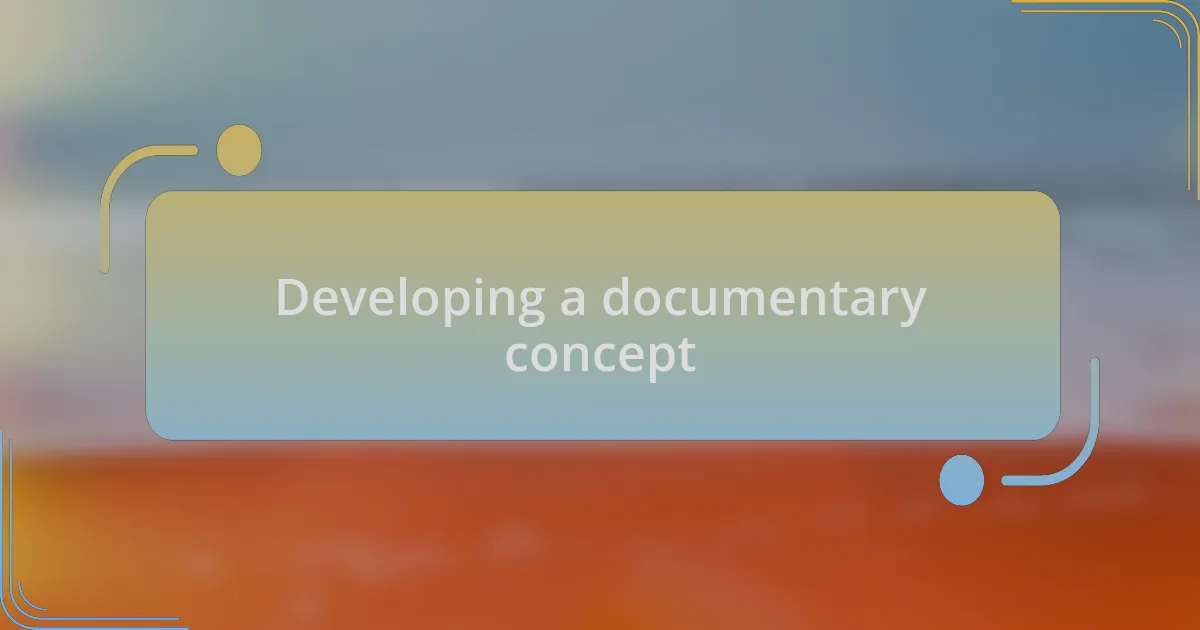
Developing a documentary concept
Developing a compelling documentary concept starts with a question that sparks your curiosity. I recall the moment when I posed the question, “What stories are hiding in plain sight?” This became the catalyst for my first documentary about urban gardeners striving to cultivate fresh produce in a concrete jungle. It was in this initial questioning phase that I learned how powerful a simple idea could be when fueled by passion and personal connection.
Once I settled on a topic, I found that immersing myself in the subject matter became crucial. I spent countless hours attending community gardening events, chatting with locals, and hearing their stories. Have you ever noticed how an idea evolves when it’s exposed to real-life experiences? It was through those engaging conversations that I refined my focus, realizing that the documentary was less about gardening techniques and more about resilience and community spirit.
Finally, I understood that every good concept needs a hook to captivate the audience. For my project, I created a narrative arc that followed several urban gardeners and their struggles against the odds. This storytelling structure was essential in shaping my message. I found that when viewers can relate to the characters, they become more invested. Isn’t that the goal of every documentary? To not just inform, but to inspire and resonate on a personal level?
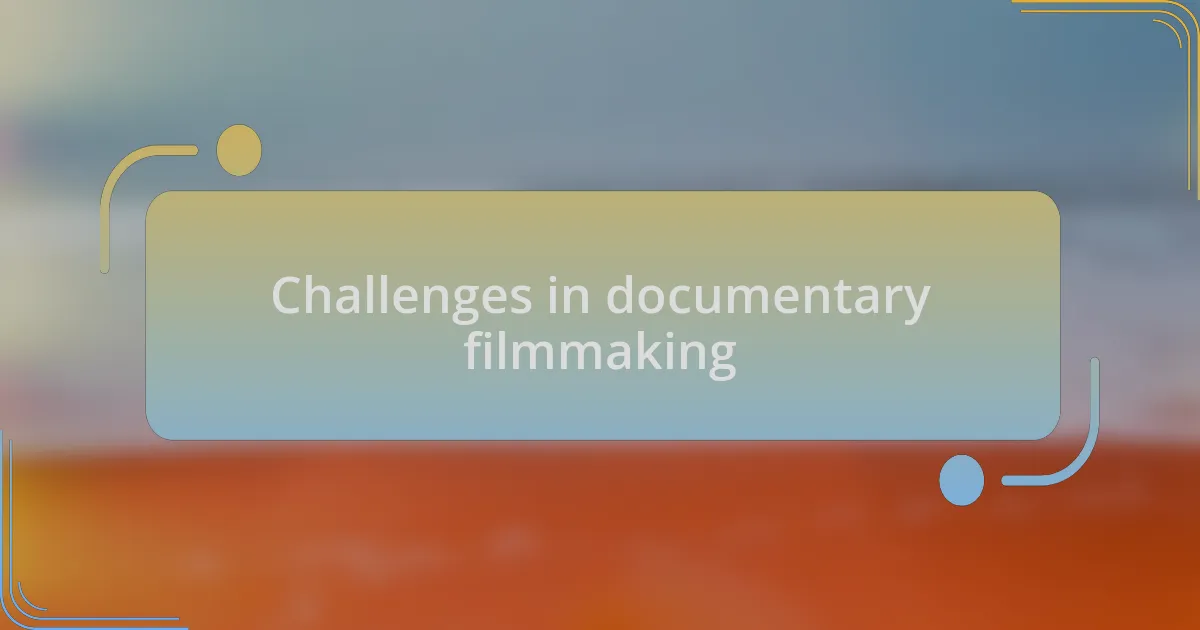
Challenges in documentary filmmaking
One of the biggest challenges I faced in documentary filmmaking was gaining the trust of my subjects. I remember a situation where I approached a community gardener who had reservations about being filmed. It took multiple conversations, sharing my intentions, and even participating in their gardening work before they opened up to me. Have you ever tried to capture someone’s story when they’re hesitant to share? That initial barrier can feel daunting, but patience and genuine interest can turn reluctance into openness.
Another hurdle that often arises is the unpredictable nature of events outside of your control. During the filming of my documentary, a sudden storm unexpectedly destroyed a community garden that I had planned to showcase. This forced me to adapt quickly, scrambling to find alternative stories and angles. It taught me that flexibility and creativity are essential in documentary filmmaking. Have you had to pivot in a project unexpectedly? It’s those moments that often lead to discovering richer narratives.
Lastly, funding can pose a significant challenge in bringing a documentary to life. I distinctly recall days spent applying for grants and pitching to potential sponsors, pouring my heart into proposals that often went unanswered. It made me realize how crucial it is to plan financially and creatively. Have you felt the strain of limited resources while pursuing a dream? This is where resourcefulness becomes your best ally, and sometimes, it leads to collaborations that enhance your project in unforeseen ways.
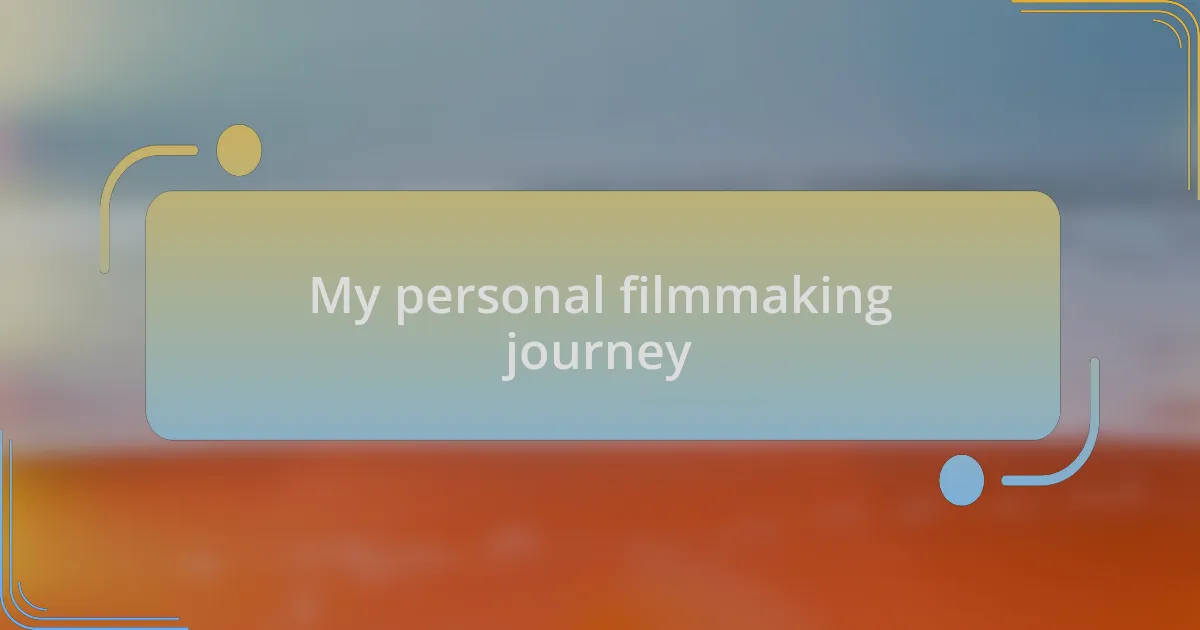
My personal filmmaking journey
When I first picked up a camera to document a local art festival, I had no idea this would ignite my passion for storytelling. At that moment, I was captivated by the vibrant colors and the buzz of creativity. I felt like a child again, discovering a new world, but I quickly realized that capturing authenticity required more than just pressing a button. Have you ever felt overwhelmed by the sheer responsibility of telling someone else’s story?
As I delved deeper into filmmaking, I discovered that my perspective often shaped the narrative. While working on a project about social justice, I initially struggled to balance my viewpoint with honesty. It dawned on me that vulnerability played a crucial role in building trust with my subjects. Have you ever found it difficult to be open, even with your camera in hand? Those moments of vulnerability not only deepened my connection to the story but also revealed layers I never anticipated.
The emotional rollercoaster of documentary filmmaking became apparent when I lost a key interviewee days before a deadline. I remember sitting in my editing suite, feeling defeated and questioning my abilities. But as challenging as that moment was, it ignited a resolve within me to find new voices and perspectives. It made me wonder, how do we turn our setbacks into catalysts for creativity? This experience reinforced that resilience is often the backbone of documentary filmmaking, revealing just how intertwined our personal journeys are with the stories we choose to tell.

Lessons learned from my experience
One of the most significant lessons I learned was the value of preparation and spontaneity. While filming a documentary on a local community sports team, I meticulously planned my shots and interviews. Yet, during a pivotal game, unexpected moments emerged—an athlete overcoming odds, a coach delivering a heartfelt speech. I realized that while planning is vital, being open to the unplanned can often lead to the most compelling footage. How often do we let life’s spontaneity shape our stories?
Additionally, collaborating with diverse voices taught me the importance of active listening. In one project, I interviewed individuals with vastly different experiences and backgrounds. At first, I was eager to guide the conversation to fit my vision. However, I soon discovered that by simply listening and genuinely engaging with their stories, I uncovered deeper insights and emotions that enriched the narrative. Have you ever found that the best stories come not from what we want to say, but from what others have to share?
Lastly, I learned that imperfection is part of the process. Early on, I often obsessed over every detail during editing, striving for a flawless product. But after sharing a rough cut of my first documentary with friends, I was surprised by their appreciation for the rawness and real moments. This experience opened my eyes to the fact that authenticity often triumphs over perfection. How can we embrace our flaws and let them enhance our storytelling?